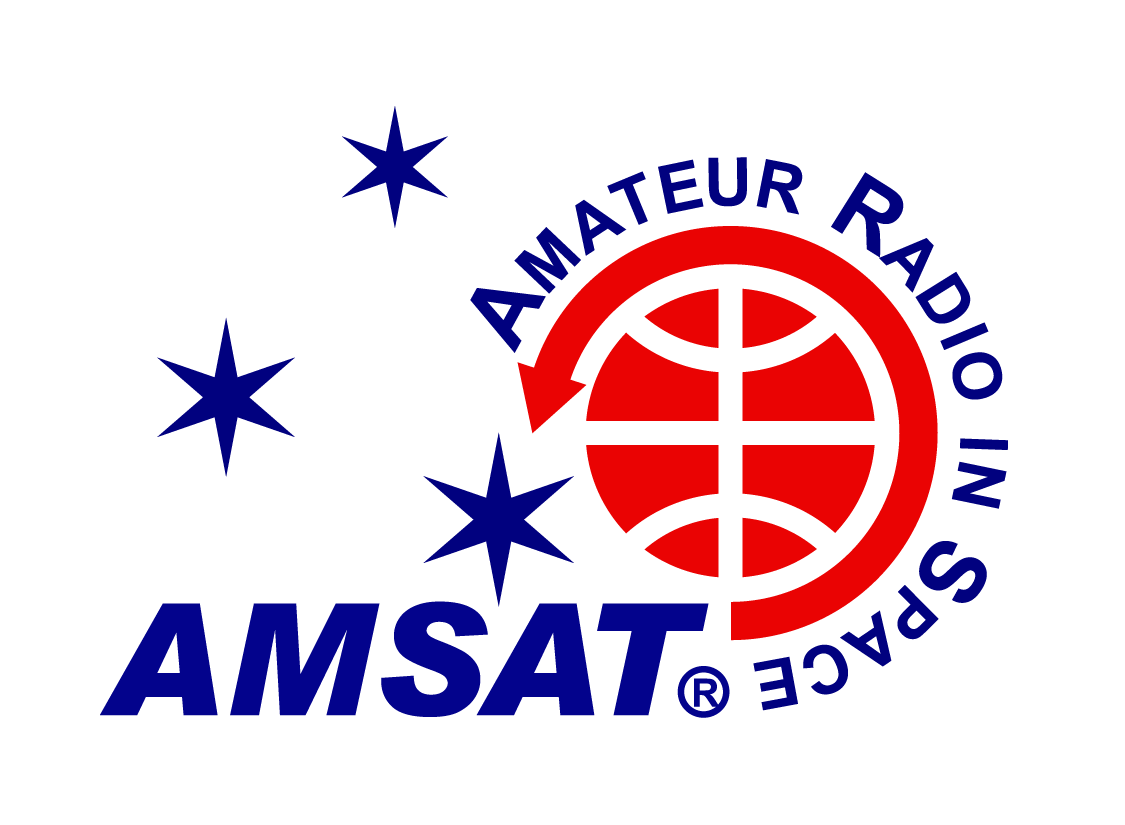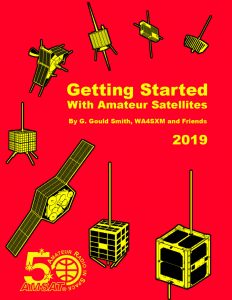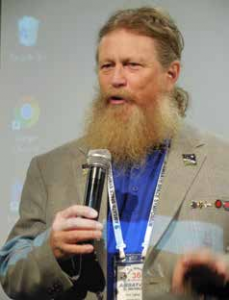AMSAT NEWS SERVICE
ANS-033
The AMSAT News Service bulletins are a free, weekly news and information service of AMSAT, The Radio Amateur Satellite Corporation. ANS publishes news related to Amateur Radio in space including reports on the activities of a worldwide group of Amateur Radio operators who share an active interest in designing, building, launching and communicating through analog and digital Amateur Radio satellites.
The news feed on https://amsat.org publishes news of Amateur Radio in space as soon as our volunteers can post it. Please send any amateur satellite news or reports to: ans-editor at amsat dot org. You can sign up for free e-mail delivery of the AMSAT News Service Bulletins via the ANS List; to join this list see: https://www.amsat.org/mailman/listinfo/ans
In this edition:
- HuskySat-1 Deployed, Telemetry Beacon Active
- Free Digital Copy of “Getting Started with Amateur Satellites” Now Available for New or Renewing Members
- Joe Spier, K6WAO, Resigns as AMSAT President
- Melissa Pore To Be Honored at HamCation February 2020
- W1ANT Pro Satellite Tracker Announced
- AMSAT Argentina Drifting APRS Buoy on 145.825 MHz
- Upcoming Satellite Operations
- Upcoming AMSAT Events
- ARISS News
- Satellite Shorts from All Over
HuskySat-1 Deployed, Telemetry Beacon Active
The University of Washington’s HuskySat-1 CubeSat was deployed from the Cygnus NG-12 spacecraft on Friday, January 31 at approximately 2230 UTC. HuskySat-1’s 1,200 bps BPSK beacon is active on 435.800 MHz and is decodable with the latest release of AMSAT’s FoxTelem software.
HuskySat-1 will be made available for Amateur Radio use following its primary mission to test a pulsed plasma thruster and experimental K band (24 GHz) communications system. HuskySat-1 features a 30 kHz wide 145 to 435 MHz linear transponder for SSB/CW:
HuskySat-1
– Uplink: 145.910 – 145.940 MHz LSB/CW
– Downlink: 435.840 – 435.810 MHz USB/CW (inverting)
– Telemetry: 435.800 MHz 1K2 bps BPSK
24049.00 MHz (U of Washington experimental downlink)
The TLE as of January 31, 2020 at 2339Z are:
HuskySat-1
1 99934U 1001D 20031.87746807 .00000000 00000-0 00000-0 0 13
2 99934 51.5569 307.6644 0013532 287.5589 72.3913 15.32433103 16
The latest version of FoxTelem software to decode the 1200 bps BPSK beacon is available at: https://www.amsat.org/tlm
The Fox-In-A-Box FoxTelem software has been updated for HuskySat-1 Operation at it’s download website:
http://burnsfisher.com/AMSAT/F
[ANS thanks Jerry Buxton, NØJY, AMSAT Vice President – Engineering for the above information.]
Free Digital Copy of “Getting Started with Amateur Satellites” Now Available for New or Renewing Members
While HuskySat-1 completes it’s scientific mission, check out the best resource for learning how to work through linear transponder satellites (and other types of amateur satellites). For a limited
time, AMSAT is making the “Getting Started With Amateur Satellites” book available as a download with any paid new or renewal membership purchased via the AMSAT Store. This offer is only available with purchases completed online, and for only a limited time. A perennial favorite, Getting Started is updated every year with the latest amateur satellite information, and is the premier primer of satellite operation. The book is presented in PDF format, in full color, and covers all aspects of making your first contacts on a ham radio satellite.
Please take advantage of this offer today by visiting the AMSAT store at https://www.amsat.org/shop/ and selecting any membership option. While there, check out AMSAT’s other items, including the M2 LEOpack antenna system, Arrow antennas, AMSAT shirts, and other swag. Be sure to view your cart before going to checkout. If you add a membership and then go directly to checkout, you’ll never see an option to add your free gift.
If you have trouble selecting your free gift, please see this YouTube video to see the steps necessary. https://youtu.be/oRqk5Am-UzE
[ANS thanks the AMSAT Office for the above information]
Joe Spier, K6WAO, Resigns as AMSAT President
Joe Spier, K6WAO, has tendered his resignation as AMSAT President, citing personal reasons. Spier had served as AMSAT’s President since October 2017. Prior to his tenure as President, Spier served as AMSAT’s Executive Vice President and Vice President – Educational Relations. He also served as an AMSAT News Service Editor and as a member of the ARISS Education Team.
Under the AMSAT bylaws, Executive Vice President Paul Stoetzer, N8HM, assumes the office of President until the next meeting of the Board of Directors.
Stoetzer said “I want to thank Joe for his many years of service to AMSAT in a variety of roles. I especially want to recognize his efforts to mark AMSAT’s 50th Anniversary with special events at the
Dayton Hamvention and AMSAT Symposium. His leadership in bringing together a variety of figures from the history of amateur radio in space in Arlington, VA this past fall helped to make the Symposium a very special event.”
[ANS thanks the AMSAT Office for the above information]
Melissa Pore To Be Honored at HamCation February 2020
Melissa Pore, an ARISS-US Education Committee member, recently earned Orlando HamCation’s 2020 Carole Perry Educator of the Year award. She will be feted at their February convention; the award recognizes teachers making outstanding educational contributions.
Melissa is an engineering and computer science teacher at Bishop O’Connell High School in Arlington, VA. She led weeks of STEM and radio activities leading up to the school’s 2018 ARISS contact. She heads the school’s engineering and ham radio clubs. At her previous school, she worked with the STMSAT-1 CubeSat project, the first satellite built by elementary school students. She helped staff an ARISS exhibit at the 2019 Space Explorers Education Conference in Houston and will present a workshop there in 2020. At the 2019 Space Port Area Conference for Educators, she received a plaque from the ISS National Lab SSE program citing her “service, commitment, and desire to push the boundaries of STEM Education.”
She brings her students to staff some of ARISS’s outreach exhibits, such as a 2019 one at the Smithsonian’s National Air and Space Museum Steven F. Udvar-Hazy Center.
[ANS thanks ARISS for the above information.]
W1ANT Pro Satellite Tracker Announced
Heimir, W1ANT announces that the Pro version has no ads and adds some features. Most notably the ability to group the satellites. The groups can then be enabled and only satellites from enabled groups will show up in the satellite overview.
Other features include:
- Get a list of Amateur Radio satellites visible from your current location in the next 24 hours.
- Get an overview over their paths from acquisition to loss of signal (AOS to LOS).
- Only passes above the minimum elevation are shown on the list.
- Select one of them and get information on their on-board radios.
- Select one of their radios and be able to point your phone directly at it so you can easily operate it.
- Extra information, i.e. the actual frequencies to use for uplink and downlink is also presented taken the Doppler effect into account.
Get full information on the app at the Google Play Store.
[ANS thanks Heimir Thor Sverrisson, W1ANT for the above information.]
AMSAT Argentina Drifting APRS Buoy on 145.825 MHz
On Thursday, January 30, 2020 at 1400 GMT AMSAT Argentina deployed a drifting buoy on South Atlantic Seas that aims to transmit APRS on the satellite packet frequency of 145.825 MHz. WSPR will also be transmitted. AMSAT Argentina reports the APRS beacon, callsign LU7AA-11, will initially be on Argentina’s APRS frequency of 144.930 MHz but will change frequency to 145.825 MHz so that it can be digipeated by the amateur packet radio satellites. The WSPR beacon will run 900 mW on 14095.6 kHz with the call sign LU7AA.
Release will be 100 km offshore Mar del Plata coast, seeking east aiming currents/winds. The objective is to track sea currents tracking and HF/VHF/SAT QRPp propagation tests. AMSAT Argentina, LU7AA, will appreciate WSPR stations receiving/reporting 20M. Further information and pictures at http://amsat.org.ar?f=buoy
[ANS thanks AMSAT Argentina for the above information.]
AMSAT, along with our ARISS partners, is developing an Amateur
Radio package, including two-way communication capability, to
be carried on-board Gateway in lunar orbit.
Support AMSAT’s projects today at https://www.amsat.org/donate/
VUCC Awards-Endorsements for February 2020
Here are the endorsements and new VUCC Satellite Awards issued by the ARRL for the period January 1, 2020 through February 1, 2020.
Congratulations to all those who made the list this month!
| KO4MA | 1701 | 1750 |
| WA5KBH | 744 | 759 |
| KE4AL | 602 | 625 |
| WD9EWK (DM43) | 597 | 600 |
| K0FFY | 260 | 576 |
| N1AIA | 257 | 494 |
| G0ABI | 320 | 453 |
| AB5SS | 306 | 411 |
| AD0HJ | 375 | 405 |
| AC9E | 353 | 401 |
| W5TD | 392 | 396 |
| K5IX | 350 | 375 |
| MI6GTY | 354 | 360 |
| W7JSD | 336 | 355 |
| PS8ET | 326 | 350 |
| ND0C | 250 | 301 |
| KJ4EU | 206 | 261 |
| KC9UQR | 196 | 240 |
| W4DTA | 180 | 217 |
| N9FN | 194 | 207 |
| N0RSR | 154 | 200 |
| VE1VOX | 155 | 157 |
| PU4JOE | 101 | 150 |
| WA9JBQ | 125 | 150 |
| K5ZM | 101 | 135 |
| S57NML | 100 | 126 |
| KN6DBC | New | 125 |
| AB4GE | 100 | 122 |
| XQ3SA | New | 114 |
| KE0WPA | New | 108 |
| RA3S | New | 107 |
| EA2AA | New | 101 |
| W4ZXT | New | 100 |
| WR0H | New | 100 |
If you find errors or omissions. please contact me off-list at <mycall>@<mycall>.com and I’ll revise the announcement. This list was developed by comparing the ARRL .pdf listings for the two months. It’s a visual comparison so omissions are possible. Apologies if your call was not mentioned. Thanks to all those who are roving to grids that are rarely on the birds. They are doing most of the work!
[ANS thanks Ron Parsons, W5RKN for the above information.]
Upcoming Satellite Operations
Satellite Shorts
Feb 15 CN78 AD0DX FM and Linear (Twitter @ad0dx)
Mar 14-15 DN26/36 KC7JPC Linears (and possibly FM)
#SnowBirdRove (EL79) – February 1-29, 2020
Joe, KE9AJ, will cross the border into Florida, seeking climatical asylum in EL79 for the entire month of February. Since he will be there for an extended period, with both FM and linear gear, keep an eye on Joe’s Twitter feed for specific pass announcements: https://twitter.com/KE9AJ
There is a possibility that Joe may have to make a pit stop in EM54 and EM53 on his way down South on February 1st. Monitor Twitter for updates.
Antigua (FK97) February 2 – 9, 2020
Mel, W8MV, will be in Antigua 2-9 February. Mel is waiting for his operating license. Will update as soon as it arrives. FM only. QSL via LOTW
Key West and Boca Grande Key (EL94, EL84+) February 9-11,2020
Clayton, W5PFG, will be in Key West, Florida (EL94) February 9 through the 11, 2020. Monday, February 10, 13:15-17:30 UTC, Clayton will operate FM & SSB satellites from EL84xm, Boca Grande Key. Listen for W5PFG near these dates for additional Florida grids such as EL79, EL89, EL99, EL86, EL96, & EL95. Keep an eye on Clayton’s Twitter feed for further announcements https://twitter.com/w5pfg
Isla Perez, Mexico (EL52, EL50, EL51) February 11 – 17, 2020
Members of Radio Club Puebla DX will be active as 6F3A from Isla Perez, Mexico, between February 11-17. The operators mentioned are Patricia/XE1SPM (Team Leader), Ismael/XE1AY, Rey/XE1SRD and Ricardo/XE1SY. Activity will be on 80/40/20/17/15/12/10/6 meters, and include the ARRL DX CW Contest (February 15-16). QSL via XE1SY. Ismael, XE1AY, reports that he is doing CW and the satellites, and will also TX from EL50 and XE1AY/mm from EL51.
Big Bend National Park (DL88) March 16-17, 2020
Ron AD0DX, Doug N6UA, and Josh W3ARD will operate from Big Bend National Park to put grid DL88 on the air. Details will be added here, as they come available, but you are more than welcome to keep an eye on their individual Twitter feeds: https://twitter.com/ad0dx, https://twitter.com/dtabor, and https://twitter.com/W3ARDstroke5
Please submit any additions or corrections to ke4al (at) amsat.org
[ANS thanks Robert Bankston, KE4AL, AMSAT VP – User Services, for the above information]
DX Satellite Operations on QO-100
- Matteo, IZ4YGS will be QRV as 9G5GS from Sanzule, Ghana from February 1 – 26. He plans some activity on Satellite QO-100. QSL direct to home call.
- Special event station II3BIA will be QRV from February 1 – 29 during the Biathlon World Championships 2020 being held in Antholz. Activity includes possible activity on Satellite QO-100.
QSL via IN3ZWF.
[ANS thanks ARRL DX News for the above information.]
FJ, ST. BARTHEMELY. Operators Pat/N2IEN, Lee/WW2DX, Rock/WW1X and Ray/W2RE will be active as FJ/N2IEN, FJ/WW2DX, FJ/WW1X and FJ/W2RE respectively from St. Barthemely (NA-146) between February 15-22. Activity will be holiday style on various HF (160-6m)/VHF/UHF bands using CW, SSB, RTTY and satellites. QSL via their home call signs.
[ANS thanks the Ohio/Penn DX Bulletin for the above information.]
ZS95SARL celebrates the 95th anniversary of the South African Radio League, founded in May 1925 as South African Radio Relay League (renamed after WW II). QRV during the whole year on HF, VHF, UHF and via satellites. QSL via bureau.
[ANS thanks the DARC DX Newsletter for the above information.]
Upcoming AMSAT Events
Want to see AMSAT in action or learn more about amateur radio in space?
AMSAT Ambassadors provide presentations, demonstrate communicating through amateur satellites, and host information tables at club meetings, hamfests, conventions, maker faires, and other events.
Current schedule:
- February 7-9, 2020, HamCation, Orlando, FL
- February 14-15, 2020, Yuma Hamfest and ARRL Southwest Division Convention, Yuma, AZ
- February 15, 2020, Cabin Fever Reliever Hamfest, Saint Cloud, MN
- March 6, 2020, Irving Hamfest, Irving, TX
- March 14-15, 2020, Science City on University of Arizona, Tuscon, AZ
- March 21, 2020, Midwinter Madness Hamfest, Buffalo, MN
- March 21, 2020, Scottsdale Amateur Radio Club Hamfest, Scottsdale, AZ
- March 28, 2020, Tucson Spring Hamfest, Tucson, AZ
- March 29, 2020, Vienna Wireless Winterfest, Annandale, VA
- May 2, 2020, Cochise Amateur Radio Association Hamfest, Sierra Vista, AZ
- May 8-9, 2020 Prescott Hamfest, Prescott, AZ
- May 15-17, Hamvention, Xenia, OH
- June 12-13, 2020, Ham-Con, Plano, TX
A copy of the AMSAT hamfest brochure is available for download at https://tinyurl.com/ANS-026-Hamfest
This color brochure is designed to be printed double-sided and folded into a tri-fold handout.
To include your upcoming AMSAT presentation and/or demonstration, please send an email to ambassadors (at) amsat (dot) org.
[ANS thanks Robert Bankston, KE4AL, AMSAT VP – User Services, for the above information]
AMSAT’s GOLF-TEE satellite recently reached a major milestone
when prototype boards transmitted telemetry for the first time.
Help support AMSAT’s path back to HEO by donating today!
https://www.amsat.org/donations/amsat-golf-program-donations/
ARISS News
Upcoming School Contacts
Possible Russian supported contact with Ecuador, via TBD. The ISS callsign is presently scheduled to be RSØISS
The scheduled astronaut is Oleg Skripochka
Contact possibly is go for Friday, February 7, 2020 UTC.
ARISS congratulations Satoshi 7M3TJZ who has now mentored 138 schools.
The following US states and entities have never had an ARISS contact: South Dakota, Wyoming, American Samoa, Guam, Northern Marianas Islands, and the Virgin Islands.
[ANS thanks Charlie Sufana, AJ9N for the above information.]
Satellite Shorts From All Over
- AMSAT-Spain Readies Two SatellitesThe Hades and EASAT-2 PocketQubes from AMSAT-Spain will carry VHF/UHF linear transponders and analog and digital two-way communications capability, including store-and-forward. Launch is planned for late 2020. More information is available at https://amsat-ea.org
[ANS thanks AMSAT-EA for the above information.]
- Training course: Product Assurance in ESA projects for SMEsOn March, 31 to April 1, 2020 the European Space Agency invites participants interested in either Hardware or Software Product Assurance (PA) to join its specialists for a two-day training
session at ESA/ESTEC (Noordwijk, The Netherlands). The course aims at providing SME participants with an overview of the PA tasks to be performed throughout a project. While a generic overview of Product Assurance tasks is provided to all participants on day 1, day 2 treats Hardware and Software PA aspects in more detail. Participants choose either the Hardware PA or Software PA module, depending on their needs and interests. More information and registration is available at https://tinyurl.com/ANS-033-ESA-PA[ANS thanks the ESA for the above information.]
In addition to regular membership, AMSAT offers membership in the President’s Club. Members of the President’s Club, as sustaining donors to AMSAT Project Funds, will be eligible to receive additional benefits. Application forms are available from the AMSAT Office.
Primary and secondary school students are eligible for membership at one-half the standard yearly rate. Post-secondary school students enrolled in at least half time status shall be eligible for the student rate for a maximum of 6 post-secondary years in this status. Contact Martha at the AMSAT Office for additional student membership information.
73 and remember to help Keep Amateur Radio In Space,
This week’s ANS Editor,
Frank Karnauskas, N1UW
n1uw at amsat dot org

 The University of Washington’s HuskySat-1 CubeSat is scheduled to be deployed from the Cygnus NG-12 spacecraft at 22:30 UTC today. HuskySat-1 carries an AMSAT VHF/UHF linear transponder that will be made available for amateur use following its primary mission to test a pulsed plasma thruster and experimental K band (24 GHz) communications system.
The University of Washington’s HuskySat-1 CubeSat is scheduled to be deployed from the Cygnus NG-12 spacecraft at 22:30 UTC today. HuskySat-1 carries an AMSAT VHF/UHF linear transponder that will be made available for amateur use following its primary mission to test a pulsed plasma thruster and experimental K band (24 GHz) communications system.